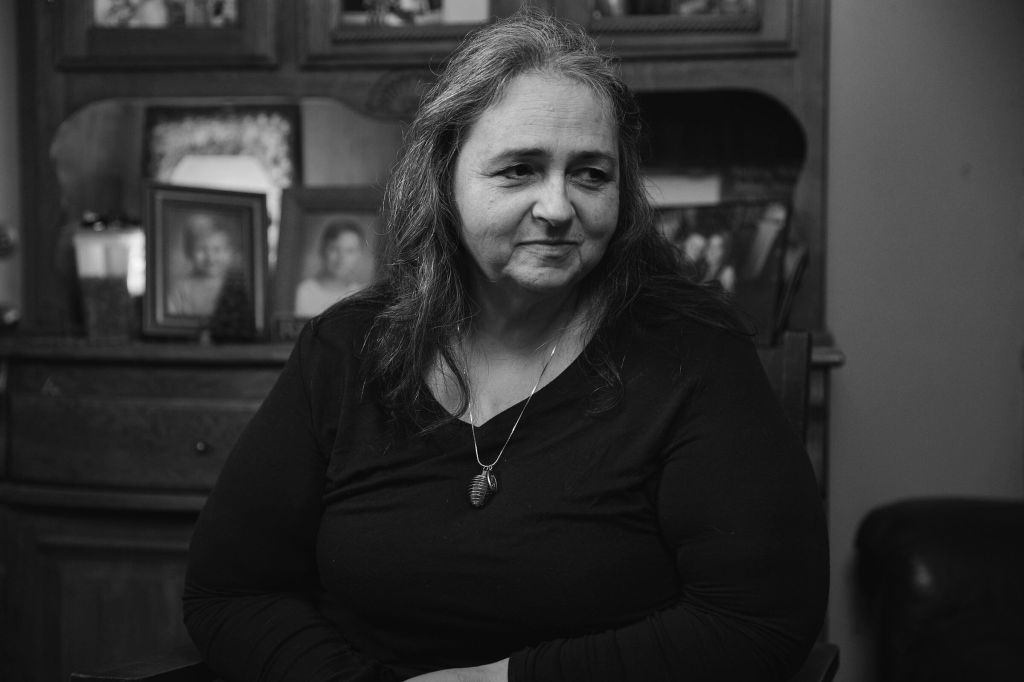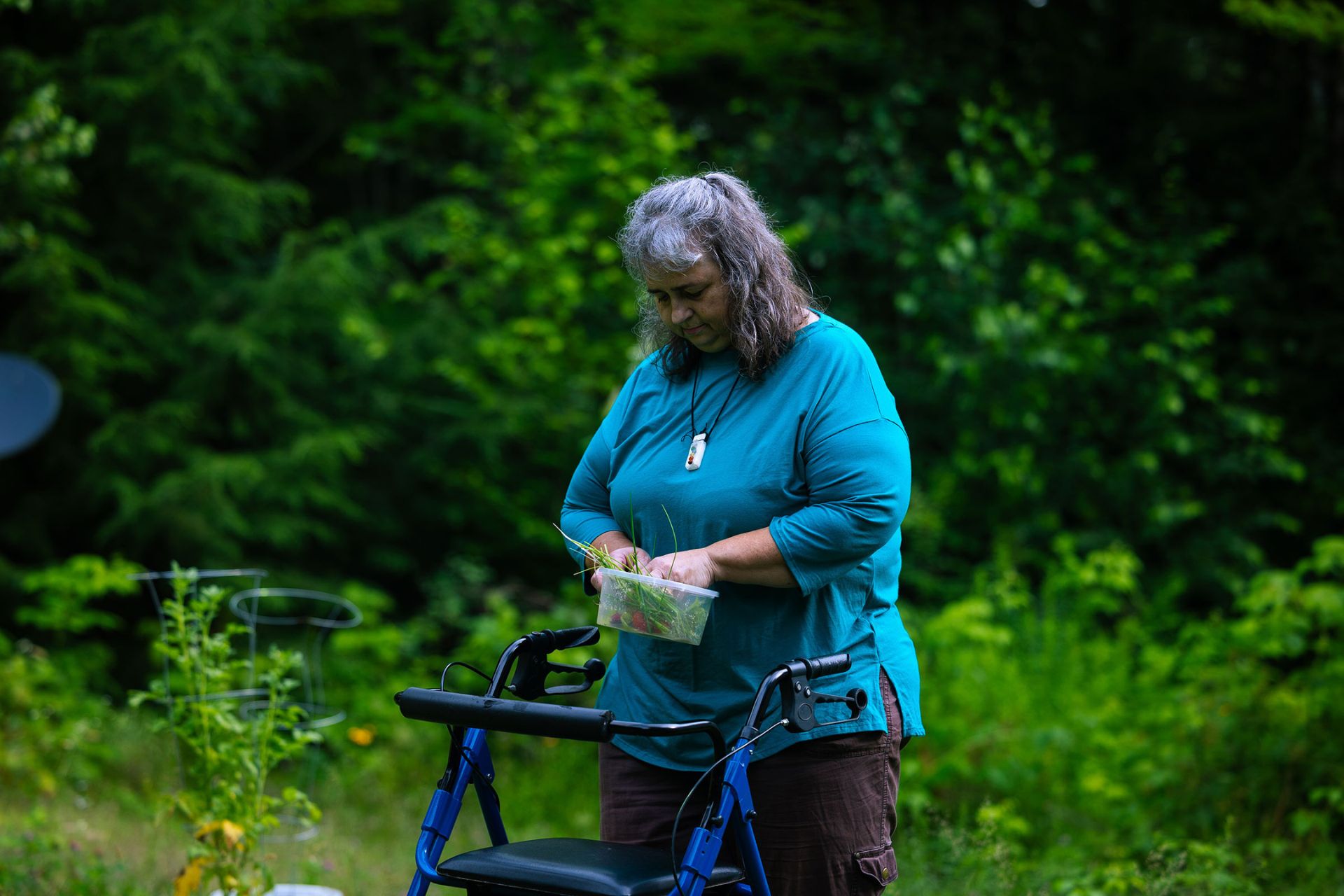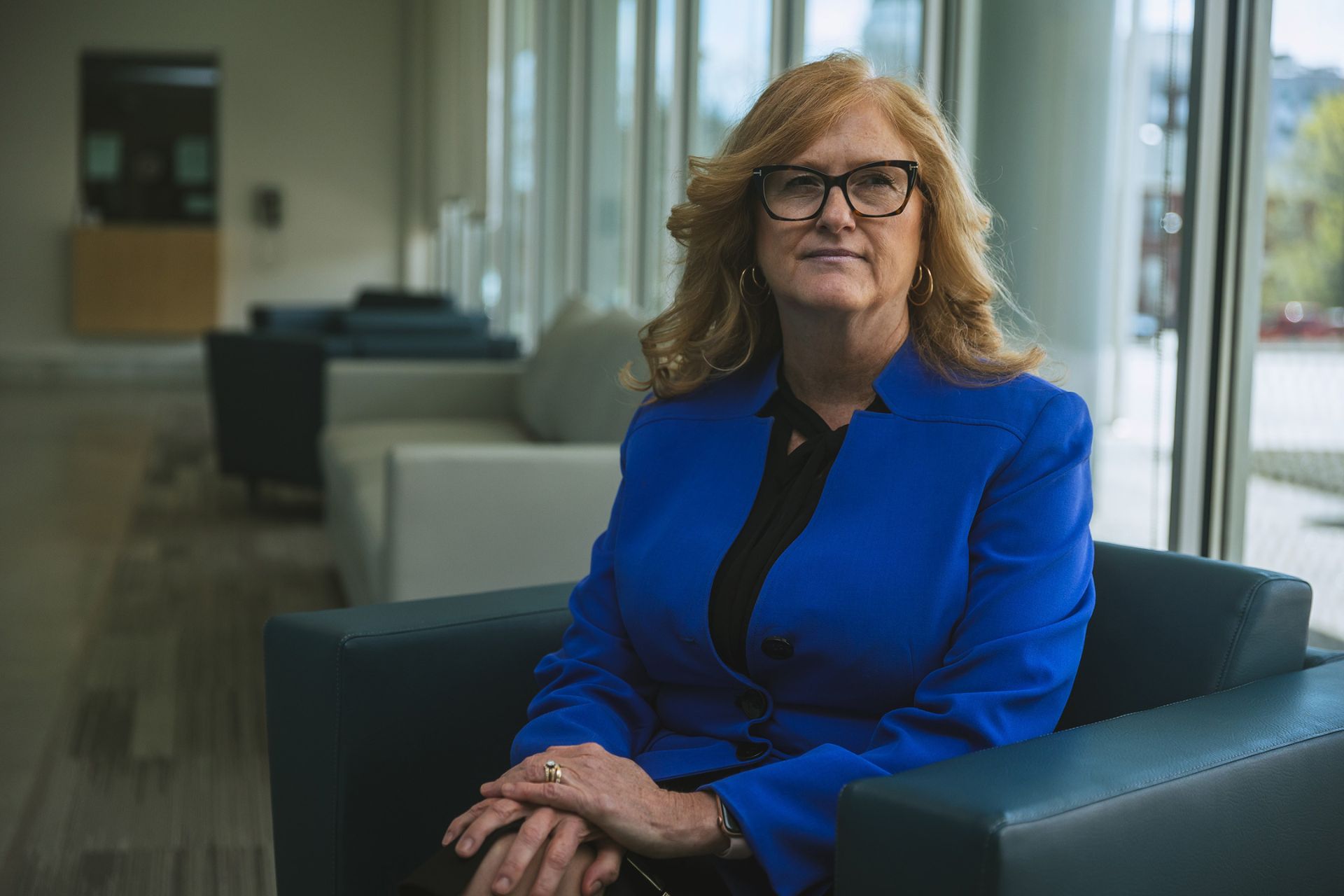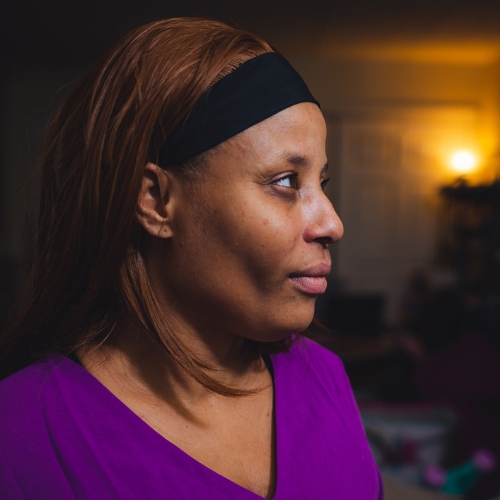
The essential role of those who’ve been there in Maine’s approach to the benefits cliff
By Gabriella Chiarenza, Fed Communities
August 10, 2023
Kandie Cleaves in Garland, Maine. Photo: Steve Osemwenkhae
As a young mother in Maine, Kandie Cleaves faced an impossible choice: go to work, as she had since age 13, or continue to have access to the medicine she needed to feel well and be able to work at all. Having suddenly developed a chronic health condition, Cleaves applied for disability and health insurance public benefits. This assistance would help her family get by financially as she learned to live with the new realities of her disability. But when she wanted to return to work, she faced losing her health insurance, without which she could not afford her medicine. There was no way she could make up the amount she would lose in benefits as soon as she started a new job. Cleaves was staring down a benefits cliff.
If you receive public assistance, you can hit a benefits cliff when your income goes up. The increase may mean you now make too much to qualify for the same amount of assistance, but not enough to cover the cost of the benefits you’re losing.
Each benefits program also may have a different income limit. If you receive benefits through a few programs, you can hit separate cliffs under each program as your income rises.
For people with disabilities who want to work, like Cleaves, the benefits cliff can be even more complicated. Chronic conditions can be expensive to care for without full health insurance coverage. People with disabilities may have a more limited range of job options open to them. And those jobs may not come with full health insurance coverage.
“The disability system is set up so that you could only take a very low-paying job and work just a few hours a week,” Cleaves explained. If you want to work more than that, you risk losing the level of disability and health care benefits you need to survive before you have the income you need to cover what’s lost.
Maine does have a program that helps some working people with disabilities keep their affordable health benefits for a longer period as their incomes increase. But some don’t qualify under the rules of this program. They are still vulnerable to a health benefits cliff.
Cleaves encountered this benefits cliff for the first time as a young mom in the 1990s. She’s since hit variations of the same cliff multiple times as her life, health, and work circumstances changed.
“If the point is to help us thrive, we should be able to work however many hours that we can handle,” Cleaves said. “It would have been so much better if the system could have supported me to be employed at a place where I could have the income to make life a little bit easier.”
‘I’ve been there’: How those who’ve faced the benefits cliff drive change (video, 5:07)
Three Mainers who navigated their own benefits cliffs share how they’re working with Maine’s policy, agency, and business leaders to take on the challenge.
Open transcript in new window >
The challenge of changing a complicated system
Some policy, state, and community leaders are trying to fix the system to do just that. But it’s a daunting challenge. Each benefit program runs under its own specific rules. Different policies govern programs in different states. And each benefit cliff can be as unique as the person encountering it.
“Solving the benefits cliff issue is, number one, a coaching challenge; number two, a policy challenge; and number three, an administrative challenge,” said Alex Ruder, one of the leaders of the Federal Reserve Bank of Atlanta’s work on the benefits cliff.
To successfully smooth out cliffs, you need creative approaches to these three types of challenges. Those devising solutions say that one of the most important elements is the deep involvement of those who’ve experienced the benefits cliff.
Cleaves has devoted years of her life advocating for change to the current system. She’s not alone among those who have experienced a benefits cliff in her desire to make things better for others in the future.
Those who’ve been there know well what people need to navigate a cliff. They also know what systemic changes might help to finally make the benefits cliff a thing of the past.
Coaching tools reveal potential cliffs ahead
It can be hard to know exactly when a benefits cliff might hit. Customizable tools can help people to identify and plan further ahead for possible cliffs. In 2019, Maine agency leaders approached the Atlanta Fed about designing a Maine-specific version of its CLIFF Dashboard tool to help impacted residents navigate the benefits cliff.
“The Atlanta Fed has been a tremendous partner” said Deputy Director Bethany Hamm of Maine’s Department of Health and Human Services (DHHS). “They develop these tools for states at no cost, and they tailor them to the policies that are here in the state of Maine or whichever state you are working in,” she explained.
The CLIFF Dashboard allows people receiving public benefits to forecast a personalized plan toward a career goal. It also shows them when key benefits might lessen or drop off entirely as they move ahead on that career track. With that information, people can then develop a plan with a coach to save for or identify additional resources to cover the anticipated drop in benefits.
Along with Alabama, Connecticut, and Florida, Maine was one of the first states to pilot this approach using state-customized tools from the Atlanta Fed. Throughout the pilot, assessments helped state officials and the Fed team understand how well the tools were working.

Kandie Cleaves picks fresh produce in her garden in Garland, Maine. Photo credit: Steve Osemwenkhae
Feedback inspires new tools to address varying needs
“I think it’s extremely important to have people with lived experience as part of this work,” said Hamm. The pilot assessments are one reason why. Vital feedback from testers experiencing cliffs inspired changes that made the tools even more responsive to their needs.
The CLIFF Dashboard was helpful for those considering different career paths and planning their longer-term goals. But interviews with those who tried the tools in 2022 revealed that other Mainers needed something different.
“We realized over the course of these pilots that some people have a different need,” said Ruder of the Atlanta Fed. “They were saying, ‘I have a job offer on the table right now. I have a raise on the table right now. I need you to walk me through the implications of that.’”
With that insight from Maine and other states trying out the CLIFF tools, the Atlanta Fed team developed a new option called Snapshot. It allows clients and coaches to plug in a particular income change along with current benefits and quickly see how that specific scenario would play out for them.
Other input from the state pilots helped the Atlanta Fed team create the Planner tool. It allows more individualized education and work planning for those using public benefits who want to move into specific career paths.
The resulting suite of three tools—Dashboard, Snapshot, and Planner—is flexible enough to meet the needs of a wider range of people navigating benefits cliffs.

Bethany Hamm at the Maine Department of Health and Human Services in Augusta, Maine. Photo credit: Steve Osemwenkhae
Busting through administrative silos
Benefits cliff tools help you understand when and how cliffs can arise. But another issue looms large: once you’re staring down that cliff, who do you call?
“Working in a department like DHHS here in Maine,” said Hamm, “it’s particularly tricky to navigate all of the various other departments that have a role in helping to alleviate the cliff issue. We tend to work in silos.”
State agencies often work in different buildings and operate different programs, each with their own rules. They don’t naturally collaborate. People experiencing a benefits cliff can’t navigate those obstacles without dealing with several agencies, which many find frustrating. The agencies must work together if they want to make things easier for those trying to balance increasing income and decreasing benefits.
When agencies like DHHS and the state Department of Labor (DOL) don’t collaborate, people can miss important warning signs. For example, someone comes into a DOL career center to talk through their career options or work on getting a better job. If the DOL center’s staff don’t see or communicate to that client how a benefits cliff could arise, then anyone using a DHHS-managed benefit who gets a job through a DOL center could unknowingly run into a cliff.
Leading by collaborative example
Recognizing this critical need to work together, Maine piloted the Atlanta Fed tools in a wide range of service locations across the state at the same time. Now, any Mainer vulnerable to a benefits cliff can learn about and plan for it, whether they first walk into a DHHS benefits appointment, a career counseling session at a DOL center, or a community organization’s information session. Everyone is providing access to the same tools and working with each other across agencies.
Beyond agency collaboration within Maine, the six New England states came together in 2017 to launch the Whole Family Approach to Jobs initiative. The effort’s guiding principle is that parents and children both benefit when each thrives at work or school. Early on, leaders put making real progress on the benefits cliff at the center of this initiative.
“This is a New England effort across the six states,” said Hamm, “so we have the opportunity to talk to each other and share experiences around how cliffs impact individuals.” Through this cross-state work, Maine, Massachusetts, and New Hampshire have each developed and tested direct approaches to combatting the benefits cliff.
Community partners cover vital costs where agencies cannot
Community resources in Maine are also working with state agencies to bridge the gap where agency programs can’t help. For instance, Maine DHHS runs a program called Higher Opportunities for Pathways to Employment (HOPE). It supports parents working toward certifications and degrees that open doors to better-paying jobs. The HOPE program covers costs that might otherwise delay or deter working parents from completing their degrees. These include expenses like tuition, child care, and technology needed for class.
But some costs fall outside what programs like HOPE are allowed to cover. These costs can still knock working parents off their career track and become cliffs of their own.
Drawing on funds from a private donation, community partner organization Maine Equal Justice (MEJ) designed the complementary Build HOPE project. The initiative offers solutions for things like car payments and surprise, sudden costs that any working parent could face.
“Say I’m a low-income parent and I’m trying to go to school and my washer and dryer break down,” said Moriah Geer, who runs the Build HOPE project at MEJ. “I don’t have time to go to the laundromat. I need to replace my washer and dryer and that is an unexpected expense I don’t have money for. So, I’m going to contact DHHS and they’re going to say, that’s not something we can help you with. But now, because of our Build HOPE project, DHHS can send them to us and we’ll be able to get them some funds to take care of that issue.”

Moriah Geer at Maine Equal Justice in Augusta, Maine. Photo credit: Steve Osemwenkhae
Policy changes to smooth out the benefits cliff
Better coordination across states, agencies, and community programs makes it easier for those facing a benefits cliff to successfully identify and navigate it. But the biggest question remains: How do we solve the problem of benefits cliffs entirely?
“When you talk about the benefits cliff, you’re really talking about the entire social safety net, tax system, and the delivery system in workforce development,” said Ruder of the Atlanta Fed. “Because it is so integrated into all three of those systems, a multipronged approach is necessary.”
Fixing the problem at the root requires policies that account for how different families actually use benefits over time. “A true policy solution alters the structure of these programs and smooths out or gets rid of the cliffs,” Ruder said.
Experience directly informs policy
Maine has accomplished some big wins in this area at the state level.
One of these successes is 2019’s LD 1772. Known as the STEP bill, it changes state policy around the Temporary Assistance to Needy Families (TANF) program. TANF provides cash assistance to families to cover certain costs like child care, training, and even diapers. It is often one of the first benefits that people lose when their income increases.
“I used the TANF program here in Maine to support myself and my children while I went into education,” Geer noted, “and I ran into a lot of issues myself navigating that program.” That experience in part led her to her work at MEJ.
The STEP bill smooths out and extends the transition period from TANF for families. “If someone is on TANF and they start earning income, that earned income is completely ignored for the first three months,” explained Geer. MEJ informed the language in the bill.
“And then for the next three months, 75% of it is ignored,” Geer continued. “Your TANF won’t move at all the first three months that you work. The next three months, it goes down a little bit, but you still have TANF coming in, and you still have access to all the different support services that are existing through the TANF program.”
The STEP bill was directly informed by people who have experienced a benefits cliff, through Maine Equal Justice’s Partner Circle program.
Partner Circle members meet with legislators, testify on bills moving through the legislature, and serve as a vital resource for those working on public assistance programs and benefits cliff solutions. Kandie Cleaves was one of the first people to join this group.
“We’ve had some successes, and that’s been huge for a lot of parents,” Cleaves said. “They’re able to get that benefit and some assistance to help them be able to go out and get a better-paying job. They’re going to have a chance.”
Drawing on experience, a business leader envisions a better system
Some benefits cliffs loom larger than others. Losing health care benefits can be particularly scary for families.
Denise Buzzelli knows well how frightening it can be when your family’s health coverage suddenly is at risk. In 2006, a job loss followed by an unexpected health emergency quickly led her family from needing no benefits at all to applying for all the benefits they needed and qualified for. She and her husband were able to get back into jobs within the next few years. The public assistance that helped them gradually fell away program by program as their income grew.
But Buzzelli remembers that getting notice they were about to lose MaineCare—the most important benefit for her family and the last one to go—felt like looking over the edge of a significant cliff. MaineCare is a benefit that provides no- or low-cost health insurance to lower-income residents.
Buzzelli had seen her husband through a major medical emergency, the cost of which had devoured their savings and led them to need benefits. Being without affordable health insurance was a terrifying prospect.
“I remember thinking, ‘Well, if I stay home and I don’t go to work, we can keep our MaineCare,’” Buzzelli recalled. “It was just this really quick, fleeting thought, because I really liked my new job and I didn’t want to quit. But I totally understand how people feel that pressure.”
Today, with ten years under her belt as the executive director of the Piscataquis Chamber of Commerce in central Maine, Buzzelli sees the full picture.
“I’ve lived on the side of needing this help and potentially not wanting to go to work because I’m going to lose all of my benefits,” she said. “And now I’m seeing the perspective of the employer. It’s a painful perspective. We have employers who are so desperate for workforce.”
Buzzelli said many employers in her rural county understand that the benefits cliff, particularly around MaineCare, can keep those who want to take a job or more work hours from doing so. She has seen them work to accommodate employees who are anxious about a potential benefits cliff. But employers are frustrated with the limits of the larger system, she said.

Denise Buzzelli at the Piscataquis Chamber of Commerce in Dover-Foxcroft, Maine. Photo credit: Steve Osemwenkhae
Extending transitional benefits to ensure working families are covered
In Buzzelli’s view, an ideal system would instead reward both workers and employers as someone shifts off of benefits and into a long-term career. Workers should get to keep some of their key benefits like health insurance for longer transitional periods, she said, and “employers should be rewarded for keeping you as an employee during that time.”
“I think a system like that where families aren’t so petrified of having to do all these things on the medical side would really encourage folks to go back to work when they can,” Buzzelli explained. “And that would open up a whole pool of workforce to our employers.”
One bill recently signed into law in Maine helps move the system more in that direction. LD 1774 offers low-income parents a 12-month extension of their established MaineCare benefits when their income starts to increase.
LD 1774’s extended MaineCare benefit gives people more time to find and transition to private health insurance. The extension lays a bridge over what could otherwise be a sudden and significant benefits cliff.
“That’s a big piece that concerns a lot of parents when they go back to work,” Maine Equal Justice’s Moriah Geer explained. The policy change means “we don’t have to worry about people having to choose not to go work because they are afraid of their children not having health care.”
Leading from experience to contribute to change
Like the rest of the country, Maine still faces the benefits cliff challenge. Federal policy questions remain as well. But today, there are more tools and lifelines in place for families facing cliffs, and the state’s systems are starting to change for the better.
“More agencies that run these different programs are working together. More and more states are working on public benefits calculators or estimators so individuals can see what could happen to their benefits if they make a change. And the way that we think about poverty as a society is starting to change,” said Moriah Geer. “It is so exciting.”
The work and insights of advocates like Kandie Cleaves who’ve been there facing similar cliffs in the past are a big reason for these promising changes. In leading states like Maine, residents’ experiences directly inform coaching, administrative, and policy approaches to the benefits cliff.
“It’s empowering when you’ve helped move policies through that have helped somebody,” said Cleaves. “And they come back and say something to you because they know that you were one of the people that was involved.”
Cleaves said she’s proud to have made this advocacy her life’s work. She continues to speak out on issues of disability, health, and poverty. To her, it’s a way to show her grandchildren how important it is to contribute to improving things for everyone.
“It’s a chance to try to change that system and make it better for yourself and for others,” she said. “That makes it all really worth it.”
Special thanks to Steve Osemwenkhae from the Boston Fed for producing, filming, and editing ‘I’ve been there’: How those who’ve faced the benefits cliff drive change.



